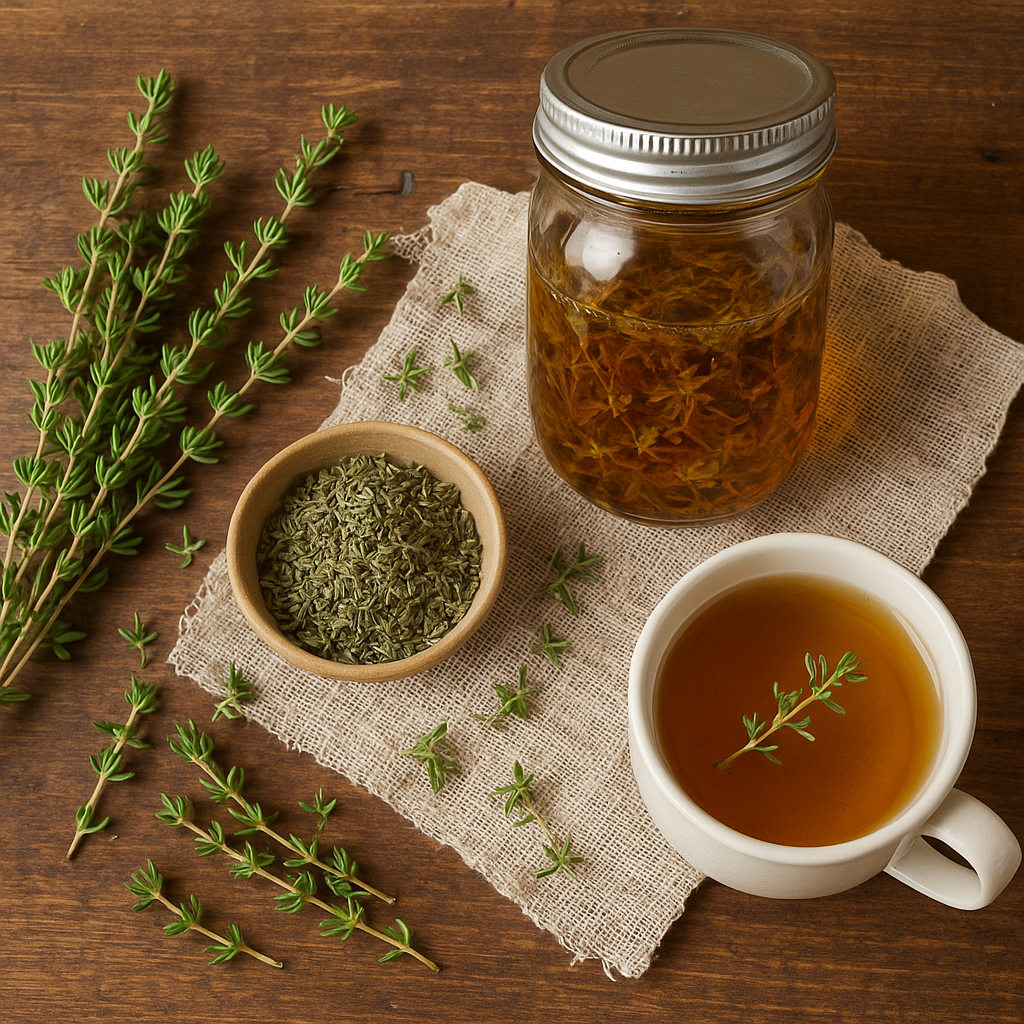Herbal Study Series: The Healing Power of Thyme
What if I told you one of the most powerful herbal remedies is already sitting quietly on your spice rack?
Welcome to week one of my four-part herbal study series, where I shine a light on the humble, aromatic, and surprisingly potent herb: thyme. Often dismissed as just another Italian seasoning, thyme is so much more than a kitchen staple. It’s a traditional medicine, a digestive aid, and a botanical ally that’s been cherished across cultures for thousands of years.
Let’s explore what makes thyme so special—and get our hands into a simple, empowering herbal project.
A Closer Look at Thyme’s Roots
Thyme (Thymus vulgaris) belongs to the Lamiaceae family, also known as the Mint family. Native to southern Europe and the Mediterranean, wild thyme can be found growing on mountain highlands and dry slopes. It is best suited for well-drained soils and full sun when growing in a garden or container. Botanically speaking, it has a woody stem, narrow, fragrant, elliptical leaves arranged opposite each other, and delicate, purple or white, tubular flowers. Thyme produces volatile oils —the source of its signature scent and many healing properties.

The medicinal use of Thyme dates back to ancient times. The Egyptians used it in embalming, incense, and ointments, and it was one of the many herbs listed on the famous Ebers Papyrus, one of the oldest and most extensive records of Egyptian medical knowledge. Greek warriors burned thyme as incense in ceremonies, associating it with courage and admiration. Even the Romans bathed in thyme-infused water to increase their valour!
It is debated that its name originates from either the Greek word thymos (“to fumigate”) or thumus (“courage”)—and whichever is true, this invigorating herb is one to respect.
Thyme for Digestion
While thyme has many medicinal properties—antiseptic, antimicrobial, expectorant, diaphoretic, to name a few—this week we’re focusing on one of its most practical actions: supporting digestion.
Thyme is a carminative herb, meaning it contains a substance that can soothe the digestive tract, reduce gas and bloating, and relieve spasms in the gut. If you’ve ever struggled with indigestion, IBS, or uncomfortable bloating, thyme might be your new best friend!
You can consume it in teas, tinctures, or even simply through your meals. But for a more concentrated and potent effect, let’s walk through how to make a thyme tincture at home.
DIY Herbal Project: Making a Thyme Tincture (Folk Method)
Tinctures are concentrated liquid extracts made by macerating, or soaking, herbs in alcohol. They’re simple to prepare and have a long shelf life —though they do require patience (six weeks of infusing!). Because these preparations are highly concentrated, small doses are used, typically a few droppersful to a teaspoon.
There are two methods of preparing a tincture: the folkloric method or the ratio (weight-to-volume) method. The folk method is a much simpler way of preparing a tincture, as it does not require precise measurements like the ratio method.
You’ll Need:
- 1 pint-sized mason jar
- Organic dried thyme (or fresh, see note below)
- 100-proof organic alcohol (vodka is common, but grain alcohol, brandy, or whiskey work too), 80 proof can work as well
- Cheesecloth or muslin
- Fine mesh sieve
- Labels
✨ Organic and non-GMO ingredients are ideal when making medicine. If organic alcohol isn’t available, use the best option you have.

Folk Method Instructions:
- Fill your jar halfway with dried thyme.
- Pour alcohol over the thyme, leaving 1 inch of alcohol over the herb (avoid it from touching the lid).
- Cap tightly and shake well.
- Label with the herb name, type of alcohol, and date.
- Store in a visible spot and shake daily for the first week.
- Mark your calendar – Let it infuse for six weeks.
- Once ready, strain using cheesecloth over a sieve into a clean jar. Earth-care tip: Compost the plant material instead of discarding it in the trash!
- Label your finished tincture and store it in a cool, dark place.
Using fresh thyme? Chop finely and fill your jar ¾ full instead of ½ full.
Dosage: 2–4 mL up to three times a day to support digestive health.
Duration: See Safety note
Healing with Food
While tinctures are quite effective, let’s not forget the power of everyday meals.
No one said it better than Hippocrates, “Let food be thy medicine and let medicine be thy food”. Incorporating herbs into meals can be a great way to add antioxidants (and other medicinal properties) to the diet, which greatly benefits digestive health. Thyme can easily be added to dressings, salads, rubs, stews, breads, fish and chicken, pastas, and even smoothies. Not only does it enhance flavor, but it also helps your body digest that food more smoothly.
A Note on Safety
While thyme is safe in culinary amounts, keep the following in mind when using it medicinally:
- Avoid high doses if pregnant—it can stimulate uterine contractions.
- Do not use thyme essential oil during pregnancy or breastfeeding.
- The length of time for taking thyme tincture can differ based on personal health objectives and the specific issue being treated. It’s advisable to seek guidance from a healthcare professional or herbalist for tailored recommendations regarding the duration of thyme tincture use. Generally, herbal remedies are taken for a period of a few weeks to several months. However, it’s crucial to observe any changes in symptoms and consult with a professional if necessary.
What’s Next in the Study?
This week, you’ve learned how to identify and use thyme as a digestive ally. You’ve even started your first herbal medicine project—congratulations!
Next week, we’ll explore thyme’s incredible effects on the respiratory system and show you how to make a soothing herbal syrup to ease coughs, colds, and congestion. Stay tuned!
See you in Week Two of the Herbal Study! 🌿


Comments are closed